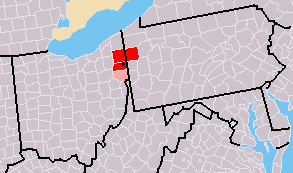Coal miners' strike of 1873 facts for kids
Quick facts for kids Coal miners' strike of 1873 |
|||
|---|---|---|---|

Mahoning, Shenango, and Tuscarawas Valleys in the Youngstown area of Ohio and Pennsylvania
|
|||
| Date | 1873 | ||
| Location |
Mahoning Valley, Shenango Valley, Tuscarawas Valley
|
||
| Goals | wages | ||
| Methods | Strikes, Protest, Demonstrations | ||
| Parties to the civil conflict | |||
|
|||
| Number | |||
|
|||
| Casualties and arrests | |||
|
|||
The Coal miners' strike of 1873 was a big protest by coal miners. They were upset about their pay being cut. This strike happened in the Mahoning, Shenango, and Tuscarawas Valleys. These areas are in northeastern Ohio and northwestern Pennsylvania.
The strike in the Tuscarawas Valley lasted for six months. In the Mahoning Valley, it went on for four and a half months. However, the miners did not win. The mine owners brought in new workers to replace the strikers. Also, companies found other types of coal to use. This forced the organized miners to go back to work for less pay.
Contents
What Was the Coal Miners' Strike of 1873?
In 1872, coal miners in this area earned about $1.10 for each ton of coal they dug. Later that year, they asked for a small pay raise. They wanted an extra $0.15 per ton. But the mine owners wanted to cut their pay instead. They wanted to pay $0.20 less per ton.
By January 1, 1873, over 6,000 union miners stopped working. They were protesting the proposed 25% pay cut. News reporters from local and national papers wrote about the strike. They reported on fights between the striking miners and the new workers.
Strikebreakers and New Workers
Mine owners started a new way to deal with strikes. They brought in workers from far away to replace the striking miners. These new workers are called "strikebreakers." Some came from the Port of New York and other cities on the East Coast. Others came from Virginia.
By February 1873, there were 7,500 striking miners. The owners brought in the first 300 new workers from Virginia. This plan worked well for the owners. So, other mine owners decided to do the same thing.
At this time, many people were leaving Italy because of hard times. The Italian government had raised taxes. Also, a war against bandits made life difficult for farmers. Thousands of Italians left their homes to find work in other countries, including the United States.
Many of these first Italian immigrants arrived in the U.S. without jobs or contacts. They often ended up in shelters in New York. When coal owners from the Mahoning Valley needed workers, they recruited about 200 Italians. These workers arrived between March and May 1873. They were sent by train to work in mines in Coalburg and Church Hill, Ohio.
The new workers from Italy and Virginia did not know they were going to be strikebreakers. They thought they were just getting jobs. During the strike, there were many fights and damage. Strikers attacked the replacement miners and those who returned to work. Local newspapers reported fires and that one person died in Church Hill.
What Happened After the Strike?
After the strike ended, many of the Italian strikebreakers stayed in the Mahoning Valley. Some settled in a place called Coalburg's Little Italy. The mine owners' actions also led to more African Americans settling in the Mahoning Valley.
Using immigrants and Black workers as strikebreakers continued for many years. This made it harder for coal miners to form strong unions. The strike showed how relationships between company owners and workers were changing after the Civil War. New technologies like the telegraph and railroads made it possible to bring in workers from far away to control the workplace.
The miners' strike began before a big economic downturn called the Panic of 1873. But even before that, railroad building had slowed down. This meant less demand for coal, iron, and steel.
Miners in the Tuscarawas Valley continued to strike even after 1873. In March 1876, a strike at the Warmington Mine became violent. The governor of Ohio, Rutherford B. Hayes, had to send state troops to restore order. A young lawyer named William McKinley helped the miners in this case without charging them money. He spoke about the dangers of mining. He pointed out that 250 miners died each year in the state, and 700 more were injured. One of the mine owners was Mark Hanna. Even though they were on opposite sides in the case, McKinley and Hanna later became political allies. This alliance helped McKinley become U.S. president in 1896.
Images for kids


